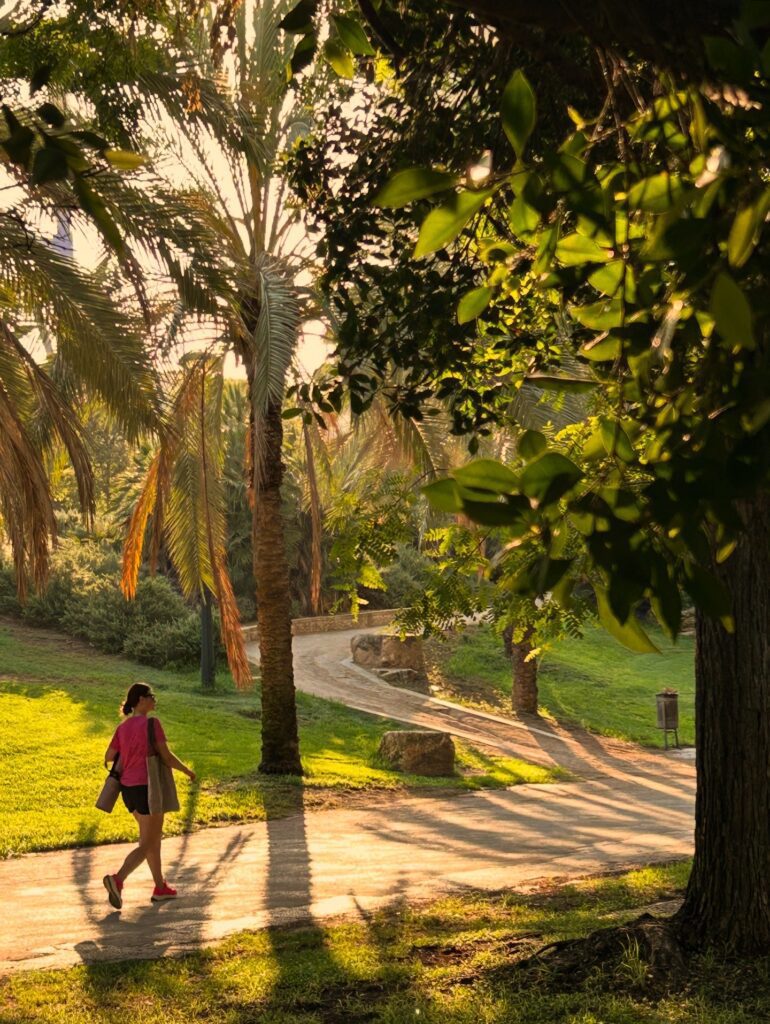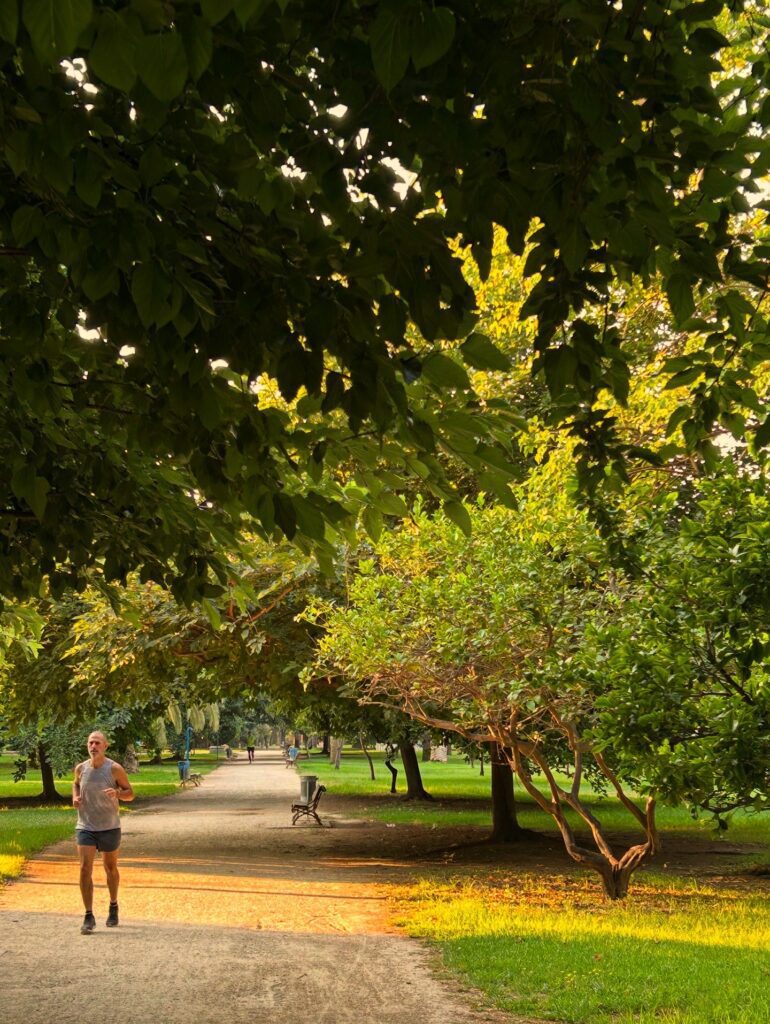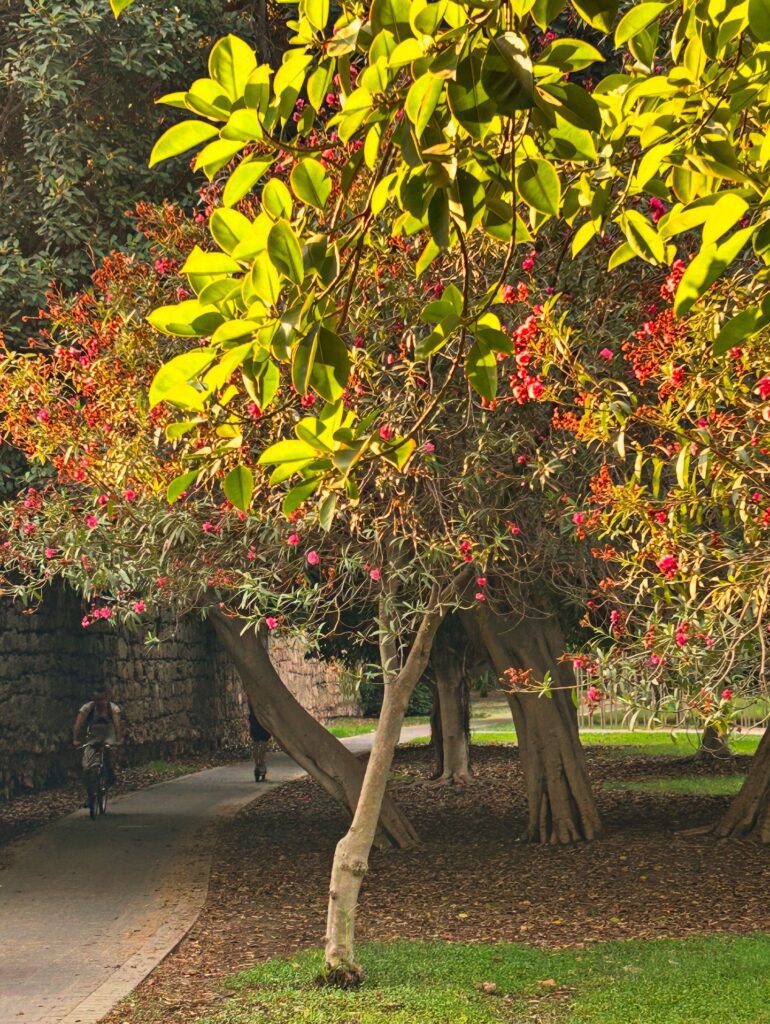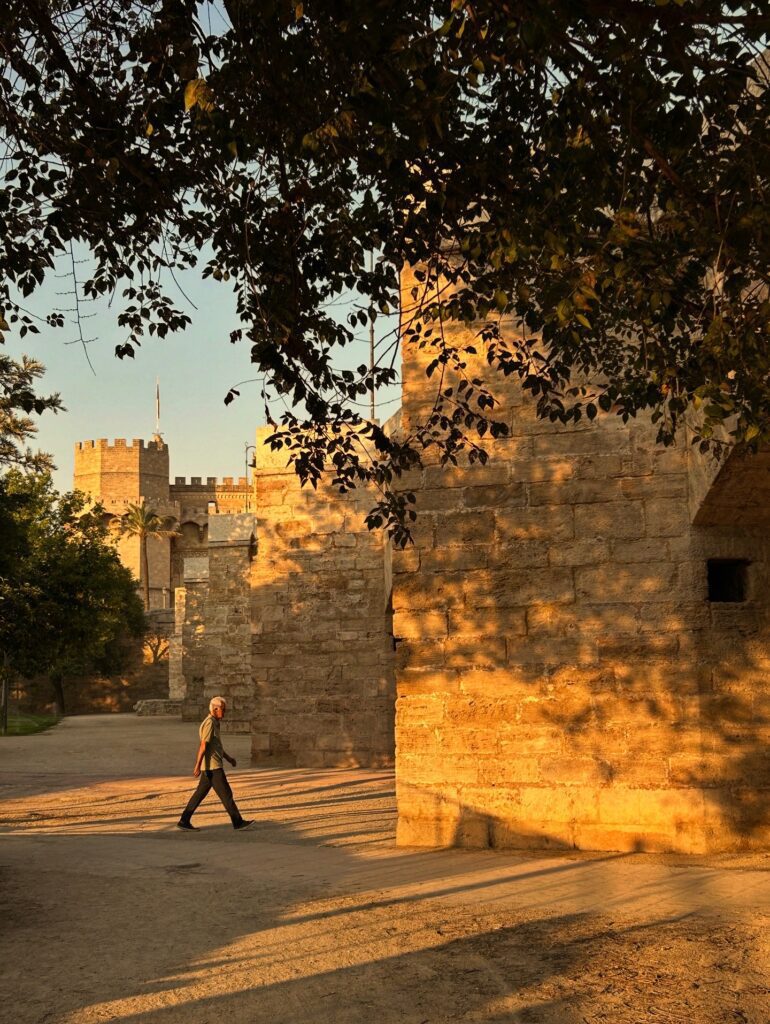Born from tragedy, the Turia Gardens have become Valencia’s greatest triumph — a nine-kilometre ribbon of green flowing through the heart of the city. Discover how a deadly flood, fierce public protests, and visionary design transformed an empty riverbed into one of Europe’s most celebrated urban parks… Photos by Paul Knowles
The Turia Gardens: Valencia’s Green Heart and River of Dreams
Stand on one of Valencia’s graceful stone bridges at dusk, and you’ll see a ribbon of green unfurling beneath you. A park that seems to flow like water, weaving through the city’s heart. The Turia Gardens, or Jardín del Turia, is no ordinary park. It is a story of disaster and rebirth, of a city that turned catastrophe into beauty, and of a people who reimagined their relationship with nature. It is, quite literally, Valencia’s river transformed into a garden. It’s the longest urban park in Spain, and one of the most ambitious civic projects in Europe.
A River That Once Ran Here
Long before bicycles glided along its paths and jacaranda trees scattered purple blossoms on morning joggers, the Turia was a living river. It meandered for 280 kilometres from the Montes Universales in Teruel. Then descended through fertile plains before embracing Valencia and spilling into the Mediterranean. For centuries, it was the city’s life source. It carried water for crops, serving as a trade artery, and shaping the geography of the settlement.
But the river had a temper. Seasonal rains could swell it into a dangerous torrent. And while Valencians learned to live with its moods, the events of October 14, 1957, changed everything.
The Great Flood of 1957: The Day the River Took the City
That autumn had been relentlessly wet in the Turia basin. Rain poured for days in the surrounding hills, feeding the river until it could bear no more. In the early hours of that October morning, the Turia overflowed catastrophically. Two waves of water surged through the city, the second more devastating than the first. Streets became canals; trams lay half-submerged; markets drowned. The flood claimed at least 81 lives, destroyed homes, and caused untold economic damage.
The event — still known simply as la riada — left deep scars on Valencia’s memory. And with that, the city’s leaders made a radical decision: the river must be moved.
Moving a River
The Plan Sur (“South Plan”) was born. In one of the most audacious engineering feats of post-war Spain, the Turia was rerouted entirely. Engineers carved a new channel south of the city, diverting the river permanently to prevent another disaster. By 1969, the old riverbed lay empty — a long, dry scar cutting through the city.
What should be done with this space became a matter of fierce debate. Some wanted a motorway. Others, industrial zones. But Valencians, still grieving the river yet craving life and colour, demanded something different. They demanded a public space, green and open, that would belong to everyone.
The Birth of the Gardens
In 1986, the first sections of the Jardín del Turia opened to the public. Slowly, over years, the old riverbed was transformed into a 9-kilometre park. A winding paradise of palms, pine groves, fountains, and sports fields, threaded with cycle paths and playgrounds. It was not designed as a uniform space; instead, each section reflected a different style. From formal gardens to wild meadows, from cultural venues to athletic facilities.
Today, the Turia Gardens are a living museum of landscape architecture. Valencian designers such as Ricardo Bofill and Santiago Calatrava left their mark here. Bofill with the sculptural Gulliver Park, Calatrava with the City of Arts and Sciences. The latter is the iconic futurescape that crowns the eastern end of the gardens.
The Lungs of Valencia
Ask any local what the Turia means to them, and they’ll speak of it as a place of refuge. This is not just a park; it’s the city’s breathing space. They are the pulmones verdes, the green lungs, cleansing the air, cooling the summer heat, and giving life to over 3,000 species of trees and plants.
Walk here at sunrise, and you’ll see the city wake up in its embrace. Pensioners walking their dogs, students cycling to class, children chasing footballs across dewy grass. Runners glide past orange trees, lovers sit beneath magnolias, yoga groups stretch by the fountains. And all the while, the great bridges of Valencia — Romanesque, Gothic, Baroque — arch over the gardens, reminders of the water that once ran below.
A Cultural Spine
The Turia Gardens are more than nature; they are a cultural artery. Along its length, the park connects some of Valencia’s most important landmarks. At the western end rises the Bioparc, an innovative zoo where African savannahs meet tropical forests. Further east, the Palau de la Música, a glass-domed concert hall, hosts orchestras and festivals beneath the park’s trees.
And at its grand finale, the gardens open into the futuristic dreamscape of the Ciudad de las Artes y las Ciencias. Local boy Santiago Calatrava’s white-and-blue complex of museums, theatres, and an opera house shaped like a ship’s hull. Here, the park meets the Mediterranean light once more, as if the river had found its own poetic rebirth in art and science.
A Garden for All Seasons
In spring, the Turia bursts into life: almond trees froth with blossom, and orange trees fill the air with their intoxicating scent. Summer brings shade and the laughter of children playing in water fountains. In autumn, plane trees turn golden, their leaves drifting onto the cycle paths. Even in winter, the gardens are alive — with mild sunlight, the crisp air smelling faintly of pine, and locals taking their daily strolls.
Unlike many city parks, the Turia never feels dormant. Its length ensures that every visit offers a new discovery: a hidden rose garden, a chess tournament, a lone guitarist under a cypress.




A Living Legacy of the Flood
There’s a quiet poetry in the fact that Valencia’s greatest disaster gave birth to its most beloved space. The Turia Gardens are a reminder of resilience — of a city’s ability to adapt and transform. The flood of 1957 is remembered with sorrow, but also with a kind of gratitude, for without it, this ribbon of green would never have come to be.
It is also a testament to civic willpower. The gardens exist because the people demanded them, rejecting concrete and commerce for trees and playgrounds. Today, the Turia is the pride of Valencia, a model of urban regeneration studied by city planners worldwide.
“The Turia Gardens are a river still flowing — not with water, but with the life of a city that refused to let tragedy harden into concrete“
How to Experience the Turia Gardens
To truly appreciate the gardens, you must move through them — on foot, by bicycle, or even by skateboard. Begin at the Cabecera Park in the west, where lakes and wooded hills recall the river’s natural origins. Follow the gentle slope eastward, passing under bridge after bridge — each one a piece of Valencia’s architectural story. Pause at the Palau de la Música for a concert, or at the Gulliver Park to clamber over the giant’s limbs. End your journey at the City of Arts and Sciences, where water once more glistens in long turquoise pools.
At every step, you’ll see how seamlessly Valencia has woven history, culture, and nature into a single, flowing space.
The Gardens Today
More than 25 years after their completion, the Turia Gardens have become the city’s most democratic space — open to all, free for all. They host marathons, open-air cinema, book fairs, and impromptu picnics. They are a meeting place for every generation and every background.
And perhaps most importantly, they have given Valencia an identity beyond its historic old town and beaches — a reputation as a city that embraces green living, slow travel, and human-centred design.
In an age when urban spaces are often swallowed by traffic and concrete, the Turia Gardens are a gentle reminder that cities can choose another path — one where the pulse of nature beats in the heart of the streets.
Final Thoughts
The Turia Gardens are not simply a park. They are a conversation between past and present, disaster and renewal, human ambition and nature’s quiet persistence. They are a river, stilled and softened, flowing not with water but with life itself.
To stand in the gardens on a warm evening, listening to the cicadas while the domes of Valencia’s skyline blush in the sunset, is to understand what the Turia means: the soul of a city, given space to breathe.